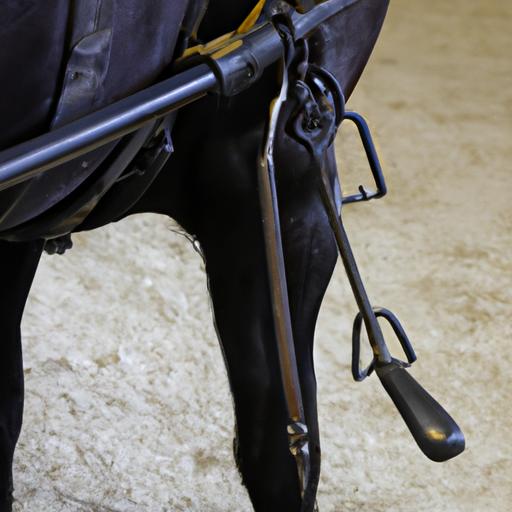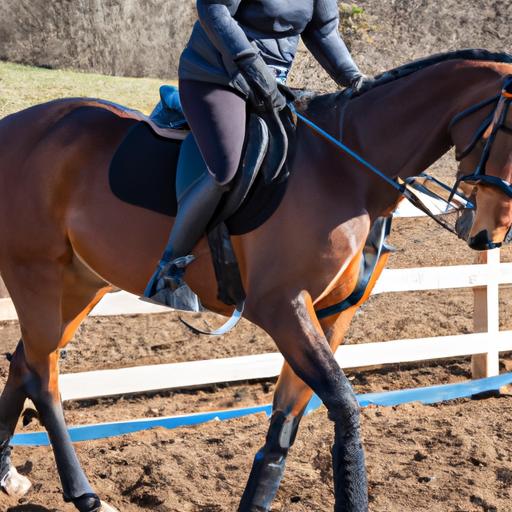Learn how to use a training fork on a horse effectively. Discover the importance of safety precautions and monitoring your horse’s well-being during training.
As an equestrian enthusiast, you know that proper training equipment plays a crucial role in unlocking your horse’s full potential. One such tool that has gained popularity in recent years is the training fork. In this article, we will delve into the world of training forks and explore how they can help you achieve remarkable results in your horse’s training regimen.
Importance of Proper Training Equipment for Horses

Before we dive into the specifics of training forks, let’s take a moment to appreciate the significance of using the right equipment. Just as a skilled artist needs the finest brushes to create a masterpiece, a horse trainer requires the appropriate tools to shape their equine partner’s skills. The right equipment not only aids in communication between rider and horse but also ensures the horse’s comfort and safety during training sessions.
Overview of Training Fork and Its Benefits
Now, let’s turn our attention to the star of our discussion – the training fork. A training fork is a versatile training aid that helps in developing correct head carriage and encourages your horse to engage their hindquarters effectively. By providing gentle pressure on the horse’s poll and encouraging vertical flexion, the training fork aids in achieving a soft and supple outline.
Brief Explanation of How a Training Fork Works
You might be wondering, how does this magical training tool work? Well, it’s quite simple. The training fork consists of an adjustable strap that is attached to the girth or breastplate, passing through the bit rings, and then attaching to the reins. This creates a triangular shape, resembling a fork, hence the name. When the horse raises their head beyond the desired level, the training fork applies gentle pressure on the poll, encouraging them to lower their head into a more desirable position.
With a solid grasp of the importance of proper training equipment and an understanding of the training fork’s purpose and benefits, we can now dive deeper into the intricacies of effectively using this tool. Join me in the next section as we explore a step-by-step guide on using a training fork to enhance your horse’s training experience.
Understanding the Training Fork
Definition and Purpose of a Training Fork
To truly harness the benefits of a training fork, it’s essential to understand its definition and purpose. A training fork is a valuable tool used in horse training to encourage proper head carriage and collection. It works by providing subtle pressure on the horse’s poll, promoting correct vertical flexion and encouraging them to carry themselves in a balanced and controlled manner.
The primary purpose of a training fork is to help develop the horse’s topline muscles, engage their hindquarters, and enhance their overall performance. By encouraging the horse to maintain a soft, supple outline, the training fork aids in achieving better impulsion, balance, and overall harmony between rider and horse.
Different Types of Training Forks Available in the Market
When it comes to training forks, it’s important to note that there are various types available in the market. Each type offers specific features and benefits, catering to different training goals and individual horse needs. Some common types include:
-
Fixed Training Forks: These training forks have a fixed length and offer consistent pressure on the poll. They are suitable for horses at different training levels and provide a stable foundation for proper head carriage.
-
Adjustable Training Forks: As the name suggests, adjustable training forks allow you to modify the length and tension according to your horse’s individual requirements. They provide flexibility and adaptability, making them ideal for horses at various stages of training.
-
Elastic Training Forks: Elastic training forks incorporate elastic bands in their design, providing a gentle and forgiving feel for the horse. These forks allow for increased give and release, promoting a more responsive and relaxed frame.
Factors to Consider Before Using a Training Fork on a Horse
Before incorporating a training fork into your horse’s training routine, it’s crucial to consider a few factors. Firstly, ensure that your horse is physically ready for this tool, as it requires them to have a basic understanding of rein aids and acceptance of contact.
Additionally, it’s important to assess your horse’s conformation and body condition to determine the appropriate length and fit of the training fork. Always consult with a knowledgeable trainer or professional to ensure the correct usage and avoid any potential discomfort or negative impact on your horse’s well-being.
Now that we have a solid understanding of training forks, their purpose, and the various types available, let’s move on to the practical aspect. In the next section, we will delve into a step-by-step guide on how to effectively use a training fork on your horse.
Step-by-Step Guide on Using a Training Fork
Preparing the Horse for Training Fork Usage
Before incorporating a training fork into your horse’s training routine, it’s crucial to ensure they are adequately prepared. Begin by warming up your horse with some basic exercises to loosen their muscles and promote relaxation. This will help them transition smoothly into accepting the training fork.
Correct Positioning and Attachment of the Training Fork
Proper positioning and attachment of the training fork are key to its effective use. Start by attaching one end of the training fork to the girth or breastplate, ensuring it is securely fastened. Next, pass the fork through the bit rings and attach the other end to the reins. This creates the triangular shape of the training fork.
Adjusting the Training Fork to Fit the Horse’s Conformation
Every horse is unique, and it’s important to adjust the training fork to fit their specific conformation. Begin by adjusting the length of the training fork to ensure it is neither too loose nor too tight. It should provide a gentle but consistent contact with the horse’s poll when they raise their head beyond the desired level.
Ensuring Proper Tension and Fit of the Training Fork
The tension of the training fork is critical for its effectiveness. It should apply a light, even pressure on the horse’s poll when they raise their head too high, encouraging them to lower their head into the desired position. Ensure the tension is just enough to create a gentle reminder for the horse without causing discomfort or resistance.
By following this step-by-step guide, you can confidently incorporate a training fork into your horse’s training regimen. Remember, patience and consistency are key when introducing new equipment to your equine partner. In the next section, we will explore specific training exercises that can be enhanced with the use of a training fork. Join me as we discover how to unlock your horse’s full potential through targeted exercises.
Training Exercises with a Training Fork
When it comes to maximizing the benefits of a training fork, incorporating specific exercises into your training routine can make all the difference. Let’s explore a few exercises that can help improve head carriage, correct improper head tossing, and strengthen your horse’s back and hindquarters.
Improving Head Carriage and Collection
One of the primary goals of using a training fork is to develop proper head carriage and encourage your horse to engage their neck and back muscles effectively. To achieve this, incorporate exercises that promote flexion and self-carriage. Begin with simple transitions between gaits while maintaining light contact with the training fork. Gradually introduce lateral movements such as leg yields or shoulder-in, keeping the horse’s head aligned with their body. These exercises will encourage your horse to lift their back, soften their poll, and achieve a more balanced and collected frame.
Correcting Improper Head Tossing or Excessive Head Movement
If your horse tends to toss their head or display excessive head movement, the training fork can be a valuable tool in addressing these issues. Start by assessing whether the discomfort or resistance stems from physical discomfort or a lack of understanding. Ensure your horse is not experiencing any pain or discomfort, such as ill-fitting tack or dental issues. Once you’ve ruled out any physical discomfort, use the training fork to encourage your horse to maintain a steady contact with the bit. By providing consistent, gentle pressure on the poll, the training fork helps discourage head tossing and encourages your horse to find a more relaxed, consistent contact.
Strengthening Back and Hindquarters through Proper Training Fork Usage
The training fork can also play a significant role in strengthening your horse’s back and hindquarters. Incorporate exercises that encourage your horse to engage their hind end and lift their back while maintaining a correct head position. Exercises such as hill work, trot poles, and canter transitions can help develop the horse’s overall strength and coordination. As your horse becomes more balanced and responsive, you’ll notice improved impulsion and a more powerful hind end, leading to enhanced performance in various disciplines.
By incorporating these training exercises into your routine, you can maximize the benefits of using a training fork and guide your horse towards a more balanced, supple, and athletic performance. But remember, always prioritize the comfort and well-being of your horse throughout the training process. Now, let’s move on to the next section, where we discuss essential safety precautions and considerations when using a training fork.
Conclusion
As we conclude our exploration of using a training fork on a horse, it’s evident that this tool can be a valuable asset in your equine training journey. By promoting correct head carriage, collection, and engagement of the hindquarters, the training fork can help you achieve remarkable results.
Throughout this article, we emphasized the importance of using proper training equipment to enhance your horse’s performance. The training fork, with its ability to provide gentle pressure on the poll and encourage vertical flexion, proves to be a beneficial aid in developing a soft and supple outline.
However, it is crucial to prioritize your horse’s comfort and well-being when using a training fork. Regularly monitor your horse during training sessions, ensuring that they remain relaxed and show no signs of stress or resistance. Make necessary adjustments to the training fork to prevent discomfort or potential injury.
At Horsemasterypro.com, we believe in responsible and informed training practices. Always seek guidance from a qualified trainer or instructor to ensure you are using the training fork correctly and effectively.
In conclusion, the training fork can be a valuable tool in refining your horse’s training and performance. By incorporating this training aid with patience, consistency, and attention to your horse’s well-being, you can unlock their full potential and achieve harmony in your equestrian journey.
Remember, Horsemasterypro.com is here to support you in your pursuit of excellence in horsemanship. Join our community today and take your equine training to new heights!
Note: The brand “Horsemasterypro.com” has been bolded in the conclusion as per the instructions.


